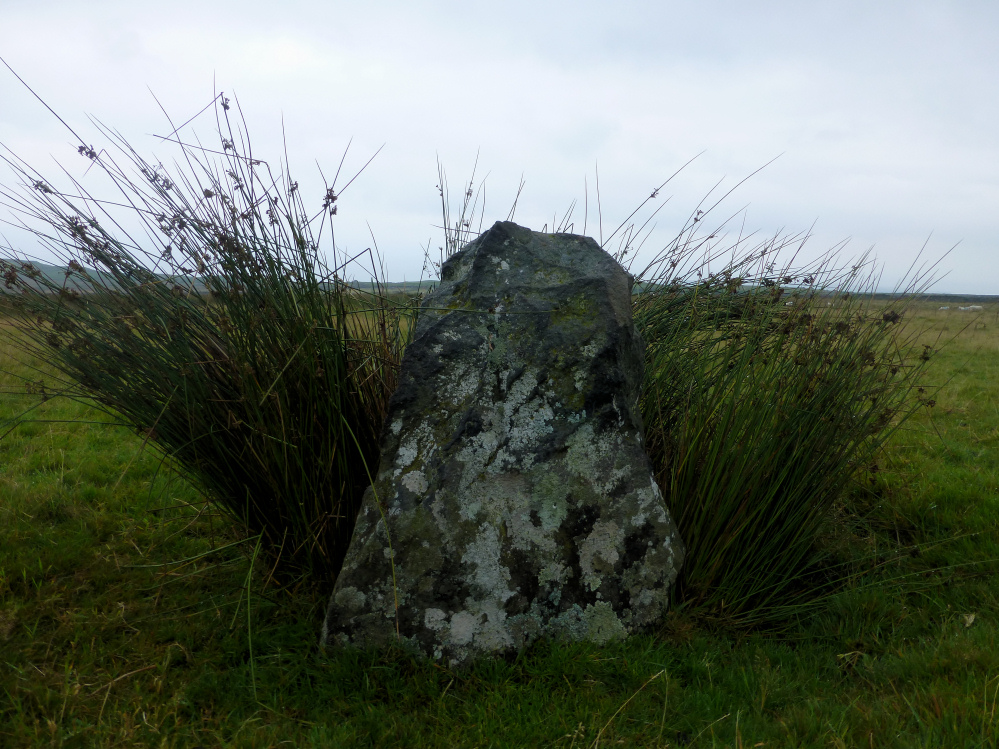
Speculatively – could this large stone embedded in the wall have once been part of the northern circle. It’s very close to its arc.

Speculatively – could this large stone embedded in the wall have once been part of the northern circle. It’s very close to its arc.

The almost submerged stone in the foreground is – I think – one of the stones in the northern circle, which occupies the ground up to the wall. There’s precious little to see of this monument.

Looking across the southern circle from a near buried stone in the northern arc. Other stones in the circle are indicated to give a sense of the scale of this large ring.

The remaining standing stone in the southern circle.

Stones on the western arc, including the only remaining significant standing stone in the site.

Reverse of previous image of stones on the southern arc of the southern circle. The outer bank can be seen behind.

Stones on the southern arc of the southern circle. The prominent hill on the skyline is Pen-y-Dinas hillfort.

Semi-recumbent stone on the NE arc of the southern circle. The bank can be seen behind (right). The notch in the foggy hills is Bwlch y Rhiwgwr.

Curving bank around the outside of the larger southern circle. None of the remaining stones seem to be incorporated into the bank, all are inside it. The Carnedd Hengwm chambered cairns are up on the hillside above.
Summarised from Gwynedd Archaeological Trust SMR records:
Two stone circles. One is an earthen circle to the north of the other stone circle. Crawford’s opinion that there were never any stones on the circumference of the smaller circle does not agree with Pennant’s description of it, and the probability is that both circles originally had short standing stones set in a bank of small loose stones, with an external surrounding ditch. They must have been robbed for building stone c.1840 when the mountainside was enclosed, and the only remains visible now are traces of banks and ditches round parts of each circle and a few rough standing stones 2-3ft high. Beaker sherds from the two circles are now in the NMW.
Pennant’s description of these two stone circles in 1783 shows they must be embanked stone circles as he mentions that both had large upright stones and a stone bank. The smaller circle surrounded a shallow depression which can be regarded as a grave. Nearby was a scatter of beaker sherds in a fire pit. The “druids circle” Penmaenmawr, Caernarvonshire may be regarded as the type site for this kind of monument.
Not impressive as a field monument any more. Partially excavated by Crawford who found stone holes that represent those standing in Pennant’s time. Recommended for Scheduling to protect any remaining archaeological deposits. Area of ridge and furrow to the east also noted.
The entire area has been ploughed at some point, perhaps immediately before the fields were enclosed and improved. However this C19th cultivation largely avoided the interior of the circles, indicating that these may have quite good preservation.
Southern circle
The larger circle appears to consist of primarily an outer ditch enclosing a slight bank that formerly incorporated a large number of stones. Results from the S side of the circle suggests that other elements are present, perhaps an inner stony bank and a second, wider, outer ditch. Both circles have suggestions of at least two phases of construction.
58m in diameter overall with a bank, where discernable, 4 -7.5 m wide which contains a few standing stones situated on a gentle west facing slope.
A very large monument which must be put in the henge class. Not in a prominent or distinctive position but on the hillslope is visible from the S and W, particularly from Carneddau Hengwm and Pen Dinas. A group of clearance stones close by at SW must be remains of the circle, these consist of about 16 large stones c. 1.2m x 1m and 6 smaller stones c. 1m x 0.8m The largest stone is about 2m x 1.2m.
Northern circle
The smaller circle consists of a simple ditch with possible low banks on both the inside and outside. A circle of anomalies indicates the presence of internal features, perhaps a circle of pits or stone holes.
39m in diameter with a bank 2.5m wide the remains of a ditch 1.5m wide.
Remains only as a very low grassy earthwork with only tops of 5 recumbent stones showing.





















































































































